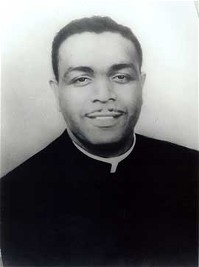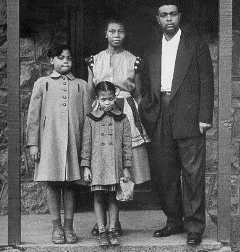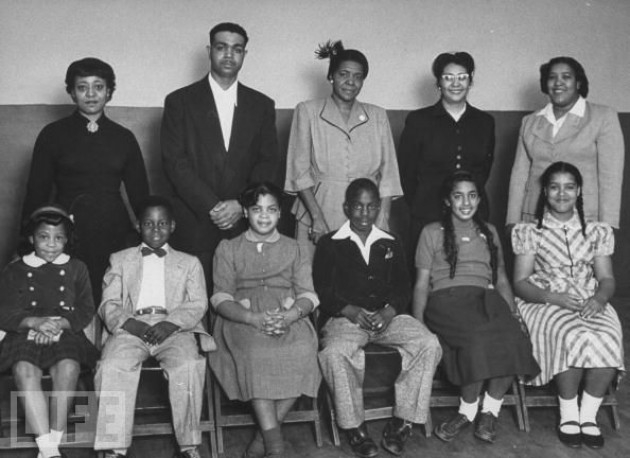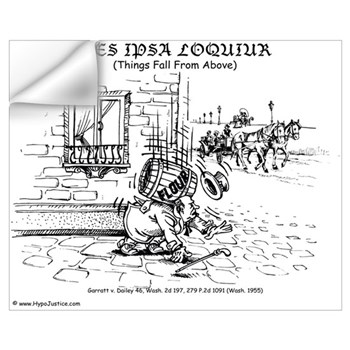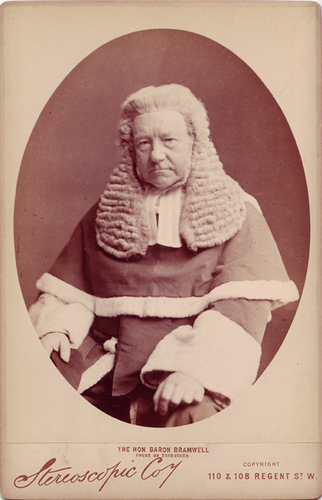Class Notes Week 01
Whitman v. Anglum Case Brief
See the case here
Map 01 and Map 02 street
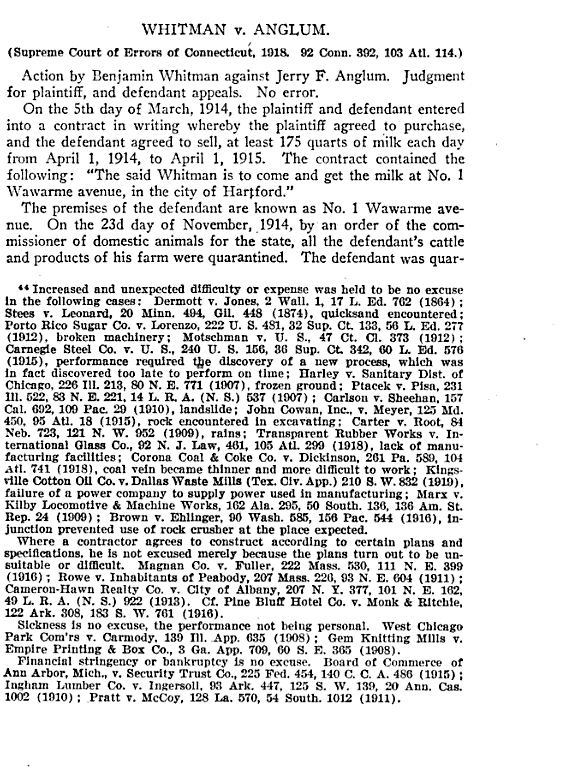
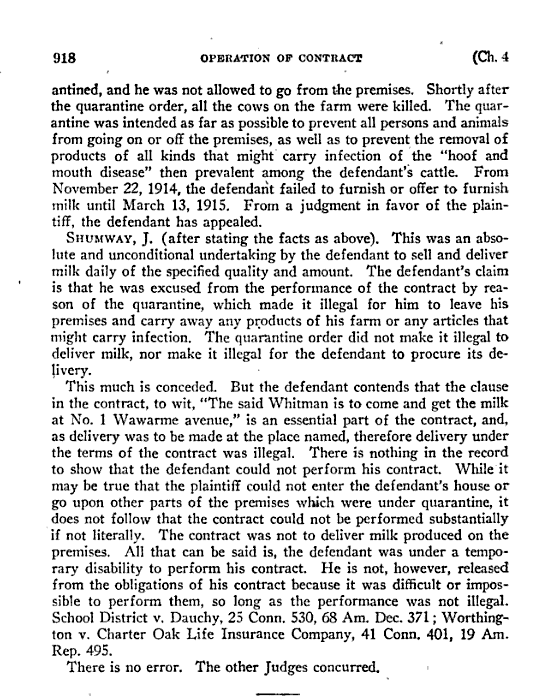
121 days @ 175 quarts of milk 21,175 quarts $119 in 1914 = $2,989.67 in 2019 Broad rule from this case that applies to all cases – contract begins when it is executed between the two parties. They know the risks they are taking. Once you have signed, you’ve agreed to something and you’re bound.
Stanford Gold v. Salem Lutheran Home Association
Understandingthe difference between Continuing care and Assisted Livingwill be important. You may also want to read this here.
map.
Plaintiff: Executive of deceased’s estate. Facts: -84-year-old Mr. Gold wanted to be a resident in life care home. -He moved into home on Aug. 1st as probationary period and paid for Aug. and Sep. -Board of directors to have a meeting to determine P’s eligibility for staying there. -Resident and board signed contract and he pre-paid the fee, he then died of stroke. Procedure: -Ct below, at trial without jury, ruled in favor of Defendant, Luthern Home. -Relatives appeal. Issues: I. When did the contract in this case begin? II. Can heirs of deceased recover damages under unjust enrichment theory when the contract had not yet gone into effect? Holding: I. The contract begins when the two parties signed the contract. II. Heirs of deceased cannot recover damages under unjust enrichment theory when the contract had not yet gone into effect. Ruling: Judgment of lower court is affirmed; ruled in favor of defendant. Rationale: -Plaintiff and Defendant entered into contract with certain assumptions. P is guaranteed place to live until he died. -Plaintiff’s death was reasonably foreseeable. -Plaintiff received a benefit for his money: peace of mind, place to stay. Evaluation: -Dissent – Justice Peters. Implied condition?
-Broad rule from this case that applies to all cases – contract begins when it is executed between the two parties. They know the risks they are taking. Once you have signed, you’ve agreed to something and you’re bound.
Class Notes Week 02
Oliver Brown
Oliver Brown's name appears first on the most famous desegregation case in the nation’s history, Brown v. Board of Education. He was a welder for the Santa Fe Railroad and a part-time assistant pastor at St. John African Methodist Episcopal Church. Courtesy of the Brown Foundation)
Heart of Atlanta Motel, Inc. v. United States
Brief Fact Summary. Prior to passage of the Civil Rights Act of 1964 (the Act), the Appellant, Heart Atlanta Motel, Inc. (Appellant) operated a motel which refused accommodations to blacks. Appellant intended to continue this behavior to challenge Congress’ authority to pass the Act.
Synopsis of Rule of Law. Congress may regulate the ability of commercial institutions to deny service on the basis of race under its power to regulate interstate commerce.
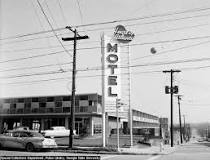
Facts. Heart of Atlanta Motel had 216 rooms available to transient guests and had historically rented rooms only to white guests. Appellant solicits business from outside the State of Georgia through advertising in national travel magazines and other media. Approximately 70% of its guests are from outside the state. Appellant contends that Congress has overreached its authority under the Commerce Clause in enacting the Act.
Issue. May Congress prohibit racial discrimination in hotel lodging under the Commerce Clause?
Mutual Pharmaceutical Company, Inc. v. Bartlett
Sympathy for respondent does not relieve us of the responsibility of following the law - Justice Alito
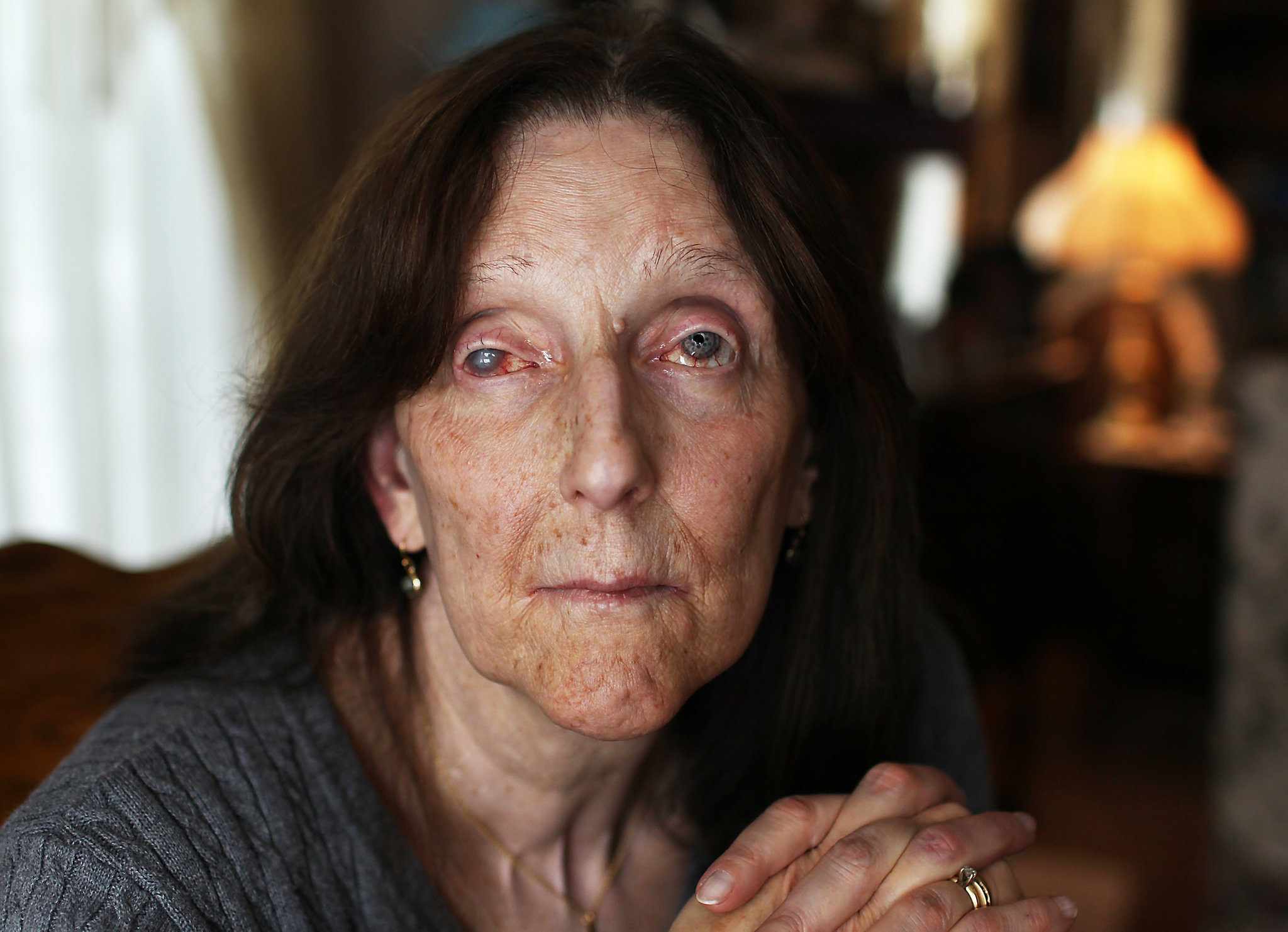
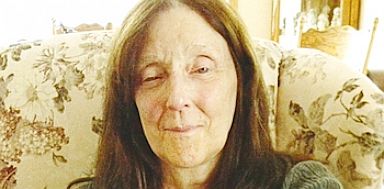
Levels of Scrutiny Under the Three-Tiered Approach to Equal Protection Analysis
|
1. STRICT SCRUTINY (The government must show that the challenged classification serves a compelling state interest and that theclassification is necessary to serve that interest.):
A. Suspect Classifications:
2. National Origin 3. Religion (either under EP or Establishment Clause analysis) 4. Alienage (unless the classification falls within a recognized "political community" exception, in which case only rational basis scrutiny will be applied).
2. Interstate Migration 3. Access to the Courts 4. Other Rights Recognized as Fundamental Quasi-Suspect Classifications:
2. Illegitimacy Minimum scrutiny applies to all classifications other than those listed above, although some Supreme Court cases suggest a slightly closer scrutiny ("a second-order rational basis test") involving some weighing of the state's interest may be applied in cases, for example, involving classifications that disadvantage mentally retarded people, homosexuals, or innocent children of illegal aliens. |
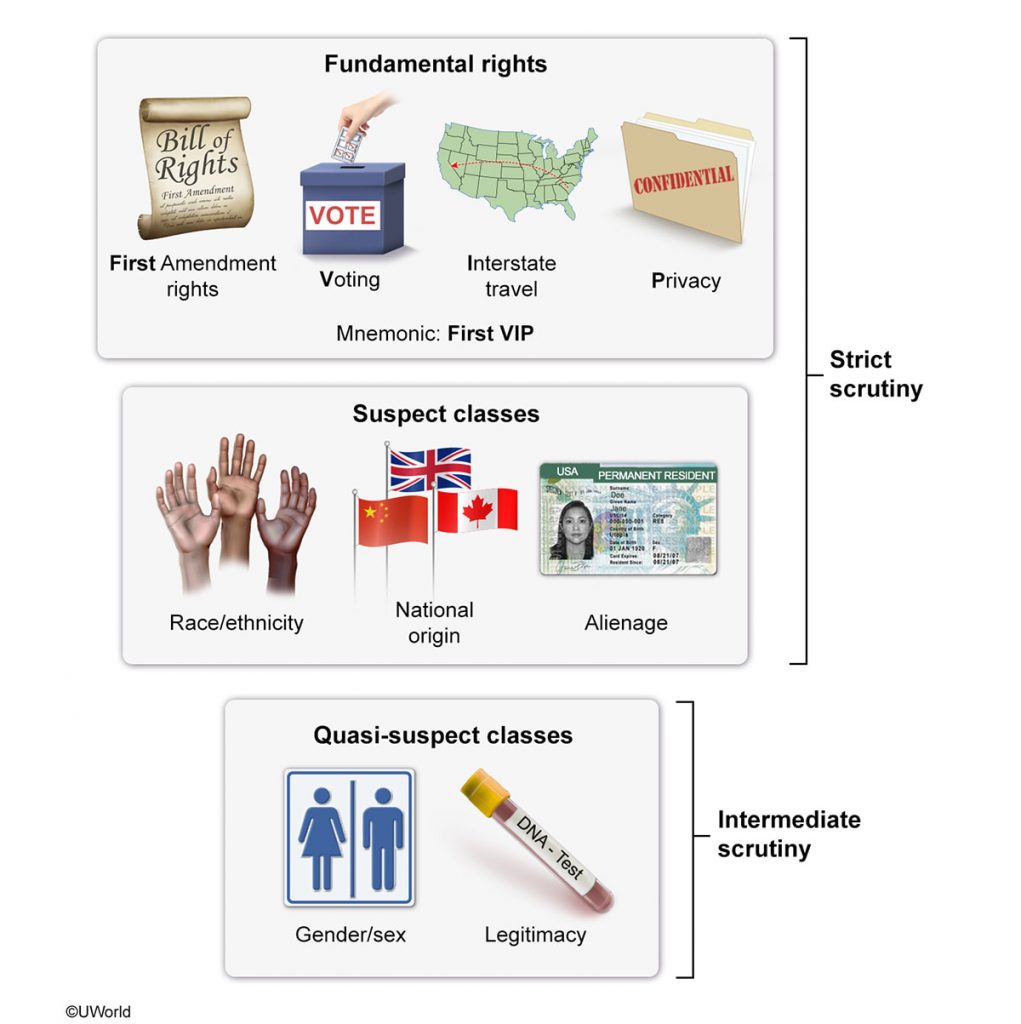
Class Notes Week 04
Byrne v. Boadle, 2 H. & C. 722, 159 Eng. Rep. 299 (Exch. 1863).
Nearly all commentators agree that the first use of the colloquial Latin tag in the negligence context came in the 1863 case of Byrne v. Boadle, in which a Liverpool flour merchant was sued by a pedestrian who had been struck and seriously injured by a barrel plummeting from the merchant's second-story storeroom. (5) The case came before the common law Court of Exchequer on appeal, and the court's head, Chief Baron Jonathan Frederick Pollock, favoring the plaintiff despite his inability to present affirmative evidence of the defendant's negligence, observed that "[t]here are certain cases of which it may be said res ipsa loquitur, and this seems one of them." (6) In context, Pollock's choice of Latin phraseology was more a gilded bauble of his classical education at Cambridge than a conscious attempt to generate a new legalism; however, subsequent jurisprudence soon minted Pollock's words into legal coinage. (7)
Byrne (P) was struck by a barrel falling from a window as he walked past Boadle’s (D) flour shop and sustained serious personal injuries. A witness testified that he saw the barrel fall from Boadle’s window but had not seen the cause. Byrne did not present any other evidence of negligence by Boadle or his employees. Boadle moved for a nonsuit on the grounds that Byrne had presented no evidence of negligence. The court granted the motion and plaintiff obtained a rule nisi. The Court of Exchequer found in favor of Byrne and reversed. Boadle appealed.
Issue
- Can liability for negligence lie solely on account of the type of accident that occurred, without direct evidence of negligence?
Holding and Rule
- Yes. Liability for negligence can lie solely on account of the type of accident that occurred, without direct evidence of negligence.
Pollock
A presumption of negligence can arise from an accident. A party need not present direct evidence of negligence when the mere manner and facts of the accident show that it could not have happened without negligence on someone’s part.
A barrel could not roll out of a warehouse window without negligence. This is an example of a case in which res ipsa loquitur (“the thing speaks for itself”) applies. It is evident that the barrel was in the custody of Boadle and its falling is prima facie evidence of negligence. A plaintiff who is injured in a such a fashion should not be required to show that the barrel could not fall without negligence. A rebuttable presumption is created that Boadle was negligent and he has the burden to prove that he was not. Boadle had a duty to ensure that those passing by his shop are not injured by objects under his control. In this case there was a scintilla of evidence with respect to negligence. The defendant failed to show that he was not negligent and Byrne is entitled to the verdict.
Judgment for Byrne affirmed.
Notes
The doctrine of res ipsa loquitur cannot be applied when there is direct evidence of the cause of the injury and facts and circumstances surrounding it.
To apply res ipsa loquitur, the following elements must be present:
- The accident must be of a type that normally would not occur in the absence of negligence.
- There was no contribution to the plaintiff’s injuries by the plaintiff or any third party.
- The source of the negligence falls within the scope of the duty owed by the defendant to the plaintiff. This usually (but not necessarily) arises where the instrument causing the injury was within the exclusive control of the defendant, or where there is an inability to identity the specific source of harm. Frequently it arises where the source of negligence lies within a group of people who are unwilling or unable to divulge the actual source.
The plaintiff must still prove all of the other elements to prove that the defendant was liable (i.e. proximate cause etc.)
Note that the theory of the negligence in Summers v. Tice is similar to the concept of res ipsa loquitur. In that case the plaintiff was shot and injured by one of two other hunters. While it was certain that one of the two men caused the harm, the plaintiff could offer no proof showing which defendant was at fault. The court shifted the burden of proof to the defendants to prove their innocence. See http://www.lawnix.com/cases/byrne-boadle.html
Liebeck v. McDonald's Restaurants, also known as the McDonald's coffee case and the hot coffee lawsuit.
The jury awarded Liebeck $200,000 in compensatory damages. This amount was reduced to $160,000 because the jury found Liebeck 20 percent at fault in the spill. The jury also awarded Liebeck $2.7 million in punitive damages, which equals about two days of McDonalds' coffee sales. Post-verdict investigation found that the temperature of coffee at the local Albuquerque McDonalds had dropped to 158 degrees fahrenheit.
The trial court subsequently reduced the punitive award to $480,000 -- or three times compensatory damages -- even though the judge called McDonalds' conduct reckless, callous and willful.
<Class Notes Week 08

